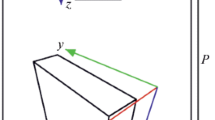Abstract
The structure of coronal teenage dentin and the development of cracks in it are studied on microand nanolevels. The material is found to fail according to a ductile mechanism on a microlelvel and according to a ductile–brittle mechanism on a nanoscale. This behavior is similar to the failure of a polyethylene film and rubber, when significant elastic and irreversible deformation precedes crack growth. The viscoelastic behavior can be considered as the reaction of dentin to an applied mechanical load.
Similar content being viewed by others
References
F. McClintock and A. Argon, Mechanical Behavior of Materials (Addison-Wesley, Reading, Mass., 1966).
R. Honeycombe, The Plastic Deformation of Metals (Cambridge University Press., Cambridge, 1968).
A. S. Argon, The Physics of Deformation and Fracture of Polymers (Cambridge University Press, Cambridge, 2013).
G. W. Marshall, “Dentin: microstructure and characterization,” Quintessence Int. 24 (9), 606–617 (1993).
R. K. Nalla, J. H. Kinney, and R. O. Ritchie, “Effect of orientation on the in vitro fracture toughness of dentin: the role of toughening mechanism,” Biomaterials 24, 3955–3968 (2003).
J. H. Kinney, M. Balooch, G. W. Marshall, and S. J. Marshall, “A micromechanics model of the elastic properties of human dentin,” Arch. Oral Biology 44, 813–822 (1999).
D. V. Zaitsev, S. S. Grigor’ev, O. V. Antonova, and P. E. Panfilov, “Deformation and failure of human dentin,” Deform. Razr. Mater., No. 6, 37–43 (2011).
J. J. Kruzic, R. K. Nalla, J. H. Kinney, and R. O. Ritchie, “Crack blunting, crack bridging and resistance-curve fracture mechanics in dentin: effect of hydration,” Biomaterials 24, 5209–5221 (2003).
D. Zaytsev, S. Grigoriev, and P. Panfilov, “Deformation behavior of root dentin under Sjögren’s syndrome,” Mater. Lett. 65, 2435–2438 (2011).
I. M. Robertson and H. K. Burnbaum, “An HVEM study of hydrogen effects on the deformation and fracture of nickel,” Acta Metall. 32 (3), 353–366 (1986).
S. M. Ohr, “An electron-microscopy study of crack tip deformation and its impact on the dislocation theory fracture,” Mater. Sci. Eng. 72 (1), 1–35 (1985).
P. Panfilov, V. Novgorodov, and G. Baturin, “An evolution of microcracks in thin foil of face-centred cubic metal,” J. Mater. Sci. Lett. 11, 229–232 (1992).
V. E. Arana-Chavez and L. F. Massa, “Odontoblasts: the cells forming and maintaining dentine,” Int. J. Biochemistry & Cell Biology 36, 1367–1373 (2004).
A. L. Volynskii and N. F. Bakeev, Solvent Crazing of Polymers (Elservier, Amsterdam, 1995).
A. L. Volynskii, L. M. Yarysheva, and N. F. Bakeev, “Crazing of polymers in liquid media—a universal, continuous method of adding modifiers to polymer fibers,” Fibr. Chem. 28 (2), 138–141 (2006).
J. F. Nott, Fundamentals of Fracture Mechanics (Metallurgiya, Moscow, 1987).
P. Panfilov, D. Zaytsev, O. V. Antonova, V. Alpatova, and L. P. Kiselnikova, “The difference of structural state and deformation behavior between teenage and mature human dentin,” Int. J. Biomater. 2016 (2016). doi 10.1155/2016/6073051v
D. Zaytsev and P. Panfilov, “Influences of the sample shape and compression temperature on the deformation behavior and mechanical properties of human dentin,” Mater. Sci. Eng. C 43, 607–613 (2014).
D. Zaytsev, A. S. Ivashov, J. V. Mandra, and P. Panfilov, “On the deformation behavior of human dentin under compression and bending,” Mater. Sci. Eng. C 41, 83–90 (2014).
D. Zaytsev and P. Panfilov, “Deformation behavior of human dentin in liquid nitrogen: a diametral compression test,” Mater. Sci. Eng. C 42, 48–51 (2014).
P. Panfilov, A. Yermakov, and G. Baturin, “The cause of cleavage in iridium single crystals,” J. Mater. Sci. Lett. 9, 1162–1164 (1990).
D. Zaytsev, S. Grigor’ev, and P. Panfilov, “Human dentin as an object of inquiry of physical metallurgy,” Probl. Stomatolog. 3, 3–14 (2013).
Author information
Authors and Affiliations
Corresponding author
Additional information
Original Russian Text © P.E. Panfilov, A.V. Kabanova, I.N. Borodin, J. Guo, Z. Zang, 2017, published in Deformatsiya i Razrushenie Materialov, 2017, No. 1, pp. 35–40.
Rights and permissions
About this article
Cite this article
Panfilov, P.E., Kabanova, A.V., Borodin, I.N. et al. Fracture mechanism of coronal teenage dentin. Russ. Metall. 2017, 879–883 (2017). https://doi.org/10.1134/S0036029517100172
Received:
Accepted:
Published:
Issue Date:
DOI: https://doi.org/10.1134/S0036029517100172




